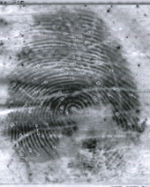การศึกษาปัจจัยด้านสภาพแวดล้อมและช่วงเวลาที่ต่างกันของคุณภาพลายนิ้วมือแฝงบนถุงพลาสติกใสด้วยวิธีปัดผงฝุ่นแม่เหล็ก The study of different environmental factors and time intervals of the latent fingerprints quality on transparent plastic bags by magnetic powder method
Main Article Content
Abstract
This research comparatively studied fingerprints quality on transparent plastic bags when exposed to three different environments: outdoor, outdoor environments covered with natural materials (Outdoor-hidden) and indoor environments. The process was conducted at 0, 1, 2, 3, 4, 5, 6, 7, 14, 21, 28, 30 and 60 days. Fingerprints were revealed with black magnetic powder and counted minutiae with the Automated Fingerprints Identification System (AFIS). Over the same period, statistical analysis confirmed that loaded fingerprints of the thumb were the highest quality in all environments and loaded fingerprints showed more quality than natural fingerprints. It was found that loaded fingerprints could be used for identification 3 days while natural fingerprints were 1 day after fingerprints exposed in outdoor environment. When exposed to outdoor-hidden environment, loaded and natural fingerprints could be verified within 7 days and 3 days, respectively. After exposure to the indoor environment, loaded fingerprints could be used to confirm a person even after 60 days while natural fingerprints could only verify a person until day 21. The result revealed that the outdoor environment has the greatest influence on fingerprints deterioration. Fingerprints remain in an environment where fingerprints were protected by covering with natural materials. addition, fingerprints exposed to indoor environments showed the least deterioration. On the basis of this study, the environment and time interval are important factors in the fingerprint degradation process. The findings will also benefit further collecting facile latent fingerprints from packaging of narcotic crime scenes case of forensic scientists.
บทคัดย่อ
งานวิจัยนี้ทำการศึกษาเปรียบเทียบคุณภาพของรอยนิ้วมือบนถุงพลาสติกใสเมื่อสัมผัสกับสภาพแวดล้อมที่ต่างกัน 3 แบบ ได้แก่ สภาพแวดล้อมกลางแจ้ง สภาพแวดล้อมกลางแจ้งที่ปกคลุมด้วยวัสดุธรรมชาติ (กลางแจ้งแบบซ่อน) และสภาพแวดล้อมในร่ม ทำการศึกษาที่ 0 1 2 3 4 5 6 7 14 21 28 30 และ 60 วัน ใช้ผงฝุ่นแม่เหล็กสีดำตรวจเก็บลายนิ้วมือและนับจุดลักษณะสำคัญพิเศษด้วยระบบตรวจลายพิมพ์นิ้วมืออัตโนมัติ (เอฟิส) ผลการวิเคราะห์ทางสถิติยืนยันได้ว่าลายนิ้วมือที่มีไขมันของนิ้วหัวแม่มือมีคุณภาพสูงสุดในทุกสภาพแวดล้อมในช่วงเวลาเดียวกัน และลายนิ้วมือที่มีไขมันมีคุณภาพมากกว่าลายนิ้วมือที่มีเหงื่อตามธรรมชาติ ลายนิ้วมือที่มีไขมันสามารถใช้ยืนยันตัวบุคคลได้ 3 วัน ในขณะที่ลายนิ้วมือที่มีเหงื่อตามธรรมชาติใช้ได้ 1 วันหลังจากสัมผัสสภาพแวดล้อมกลางแจ้ง เมื่อสัมผัสกับสภาพแวดล้อมกลางแจ้งแบบซ่อนลายนิ้วมือที่มีไขมันและลายนิ้วมือที่มีเหงื่อตามธรรมชาติสามารถใช้ยืนยันตัวบุคคลได้ภายใน 7 วันและ 3 วันตามลำดับ การสัมผัสกับสภาพแวดล้อมในร่ม ลายนิ้วมือที่มีไขมันสามารถใช้ยืนยันบุคคลได้แม้จะผ่านไป 60 วัน ในขณะที่ลายนิ้วมือที่มีเหงื่อตามธรรมชาติสามารถใช้ยืนยันตัวบุคคลได้จนถึงวันที่ 21 เท่านั้น ผลการวิจัยพบว่าสภาพแวดล้อมกลางแจ้งมีอิทธิพลต่อการเสื่อมสภาพของลายนิ้วมือมากที่สุด ลายนิ้วมือสามารถคงสภาพอยู่ได้ในสภาพแวดล้อมที่ได้รับการปกป้องโดยการคลุมทับด้วยวัสดุธรรมชาติ และรอยนิ้วมือที่สัมผัสกับสภาพแวดล้อมในร่มมีการเสื่อมสภาพน้อยที่สุด ผลการศึกษานี้กล่าวได้ว่า สภาพแวดล้อมและช่วงเวลาเป็นปัจจัยสำคัญในกระบวนการเสื่อมสภาพของลายนิ้วมือ ผลการวิจัยนี้จะเป็นประโยชน์ต่อเจ้าหน้าที่นิติวิทยาศาสตร์ในการตรวจเก็บลายนิ้วมือแฝงจากบรรจุภัณฑ์ยาเสพติดในสถานที่เกิดเหตุคดียาเสพติด
Downloads
Article Details
References
โศภชา สิงห์ทอง. (2558). ลายนิ้วมือกับการพิสูจน์เอกลักษณ์บุคคล. วารสารวิชาการแพรวากาฬสินธุ์ มหาวิทยาลัยราชภัฏกาฬสินธุ์, 2(2), 52-63.
สมจารี คันธชาติกุล. (2558). การศึกษาหาระยะเวลาการคงอยู่ลายนิ้วมือแฝงบนพลาสติก 3 ประเภทโดยใช้วิธีซุปเปอร์กลูในสภาวะแวดล้อมแตกต่างกัน. ใน การประชุมวิชาการและนำาเสนอผลงานวิจัยระดับชาติและนานาชาติ ครั้งที่ 6 (524-534). กรุงเทพฯ: มหาวิทยาลัยราชภัฏสวนสุนันทา
สำนักงานพัฒนาการวิจัยการเกษตร. (ม.ป.ป.). ฤดูกาลในประเทศไทย. เมื่อ 13 เมษายน 2565 จาก https://www.arda.or.th/know
ledge_detail.php?id=83
อภิชัย แผลงศร. (ม.ป.ป.). การระบุบุคคล. เมื่อ 13 เมษายน 2565 จาก http://med.swu.ac.th/forensic/images/AP_Identification(new)%201_60.pdf
Archer, N. E., Charles, Y., Elliott, J. A., & Jickells, S. (2005). Changes in the lipid composition of latent fingerprint residue with time after deposition on a surface. Forensic Science International, 154(2), 224-239. doi: 10.1016/j.forsciint.2004.09.120.
Ashbaugh, D. R., & Police, R. C. M. (1989). Ridgeology : modern evaluative friction ridge identification. Retrieved February 11, 2023, from https://onin.com/fp/ridgeology.pdf
Barnett, P. D., & Berger, R. A. (1976). The Effects of Temperature and Humidity on the Permanency of Latent Fingerprints. Journal of the Forensic Science Society, 16(3), 249-254. doi: 10.1016/S0015-7368(76)71068-5.
Bunter, S. (2014). How Long Can an Identifiable Fingerprint Persist on an Exterior Surface. Retrieved February 11, 2023, from https://www.semanticscholar.org/paper/How-Long-Can-an-Identifiable-Fingerprint-Persist-on-Bunter/170eb27571d22991e0
f797da1f0ad9f0f07ce5bb
Chanachinrat, G., & Girdthep, S. (2023). The comparative study of fingerprint developing methods on narcotics packaging which collected latent fingerprints for identification in Police Forensic Science Center 7. Journal of Science and Technology Kasetsart University, 12(1), 41-57.
Girdthep, S., Limwanich, W., & Punyodom, W. (2022). Non-isothermal cold crystallization, melting, and moisture barrier properties of silver-loaded kaolinite filled poly(lactic acid) films. Materials Chemistry and Physics, 276, 125227. doi:
1016/j.matchemphys.2021.125227.
McMorris, H., Sturrock, K., Gentles, D., Jones, B. J., & Farrugia, K. J. (2019). Environmental effects on magnetic fluorescent powder development of fingermarks on bird of prey feathers. Science & Justice, 59(2), 117-124. doi:10.1016/j.scijus.2018.09.004.
Peonim, V. (2017). Scope of forensic work and services. Public Health & Health Laws Journal, 3(2). 228-246.

